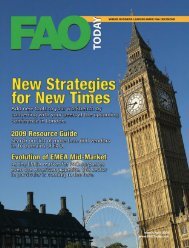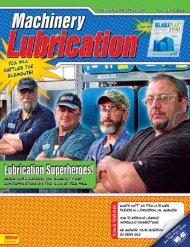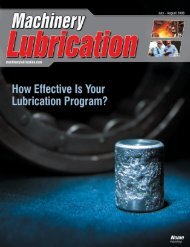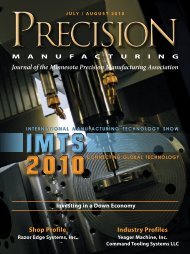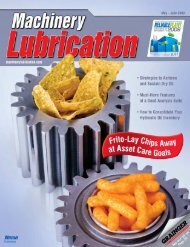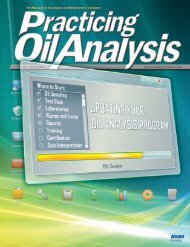• Patchless Transdermal Drug Delivery ... - Ecn5.com ecn5
• Patchless Transdermal Drug Delivery ... - Ecn5.com ecn5
• Patchless Transdermal Drug Delivery ... - Ecn5.com ecn5
Create successful ePaper yourself
Turn your PDF publications into a flip-book with our unique Google optimized e-Paper software.
6<br />
MARCH 2011 <strong>•</strong> TransDermal<br />
Excipients for TDD formulations should be nontoxic,<br />
nonirritating, and nonsensitizing to skin, even upon<br />
repeated application to the same site. The transdermal<br />
composition may use different excipients<br />
depending on the dosage form. Excipients may<br />
include solvents for the drug, thickeners, preservatives,<br />
anti-oxidants, chelating agents, fragrances, etc.<br />
A key ingredient for a patchless TDD formulation is<br />
the skin-permeation enhancer, which facilitates<br />
delivery of a therapeutically required dosage of the<br />
drug. Some of the common enhancers include oleic<br />
acid, dimethyl isosorbide, lauryl lactate, dimethyl<br />
sulfoxide, decyl methyl sulfoxide, ethoxydiglycol,<br />
N-methyl 2-pyrrolidone, and isopropyl myristate. A<br />
review by Danyi Quan, et al provides a detailed discussion<br />
of enhancers for TDD [1, 2]. Many enhancers<br />
cause skin irritation when used at higher concentrations.<br />
Therefore, a balance between drug-permeation<br />
enhancement and skin safety is important in optimizing<br />
the formulation.<br />
One of the key issues with patchless TDDs is retention<br />
of the drug and enhancer at the site of application.<br />
Lack of retention for the desired duration of<br />
time is a common problem. Nature designed the<br />
skin to shed materials adhering to it. Loss of an<br />
applied dose also can occur by transfer to other<br />
objects, such as articles of clothing, or other people.<br />
The loss results in an inadequate therapeutic effect<br />
and a shorter duration of pharmacological activity<br />
for the drug. In addition, transfer of a drug, such as<br />
testosterone, to others by touch is a particularly sensitive<br />
issue pertaining to safety of the product.<br />
An appropriate film-forming polymeric delivery system,<br />
which can serve as a matrix for the drug and<br />
enhancers, can address some of these issues; however,<br />
the use of a polymer delivery system for TDD has its<br />
own challenges. Skin is a living substrate; that is, it<br />
breathes, perspires, stretches, and contracts. The<br />
formed film must accommodate the various functions<br />
of the skin during different activities and environmental<br />
conditions, such as temperature and humidity.<br />
It must be bioadherent and possess viscoelastic properties,<br />
breathability, and moisture-vapor permeability<br />
similar to skin. In the absence of such characteristics,<br />
the film tends to feel uncomfortable or tight and peels<br />
and flakes during use. The net result is inadequate<br />
wear time and loss of efficacy.<br />
Another consideration is possible crystallization of<br />
the drug on the skin when the applied formulation<br />
dries. Other critical issues that formulators need to<br />
address in patchless TDD development include the<br />
hydrolytic and oxidative stability of the drug in<br />
aqueous or hydroalcoholic medium, pH effects, and<br />
cosmetic acceptability.<br />
Commercial Approaches to <strong>Patchless</strong><br />
TDD Products<br />
Acrux, Vivus, Ther-Rx<br />
Acrux (www.acrux.com.au) initially acquired its<br />
technology — discovered by B Finnin, B Reid, and<br />
T Morgan — from Monash University in Australia.<br />
Sunscreens have used its ACROSS ® enhancer octisalate<br />
for a long time at higher doses. It is a known,<br />
safe, nonirritating formulation and allows the passage<br />
of drugs across the barrier layer of the skin.<br />
Acrux has placed the ACROSS enhancer in a<br />
Metered Dose <strong>Transdermal</strong> System ® (MDTS), allowing<br />
application of a pre-set dose of a drug. The system<br />
also creates a patchless reservoir in the skin that<br />
can deliver drugs for various indications for human<br />
and veterinary use. Vivus (www.vivus.com) is the<br />
licensee in the USA for Acrux’s testosterone spray<br />
for women, trademarked as Luramist ® . Another<br />
ACROSS product, Evamist ® , is a 1.7% estradiol topical<br />
spray for systemic transdermal delivery of the<br />
hormone (Ther-Rx, www.ther-rx.com).<br />
Biosante, Antares Pharma, Azur Pharma<br />
Biosante Pharmaceuticals (www.biosantepharma<br />
.com) is a company specializing in products for<br />
female sexual-health and oncology. The lead is<br />
LibiGel ® , a transdermal testosterone gel for treatment<br />
of female sexual dysfunction. Antares Pharma<br />
(www.antarespharma.com), Biosante’s partner, is<br />
developing it. It is in Phase 3 clinical development<br />
under an FDA Special Protocol Assessment. Biosante<br />
intends to submit the LibiGel NDA in 2011 for potential<br />
approval by the FDA in 2012.<br />
Azur Pharma (www.azurpharma.com) in Ireland is<br />
a private pharmaceutical company focused on the<br />
Central Nervous System (CNS) and the health of<br />
women. Azur is marketing Elestrin ® , which they<br />
acquired from Biosante, in the USA. It is an estradiol<br />
gel for the treatment of menopausal vasomotor<br />
symptoms.



